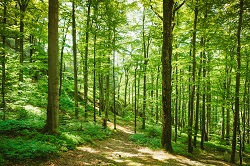Newly published findings show species-diverse forests bring greater ecological benefits
Publishing in the renowned scientific journal ‘Proceedings of the National Academy of Sciences’, researchers from the FUNDIVEUROPE (Functional Significance of Forest Biodiversity in Europe) project have highlighted how species-rich forest gives rise to a higher number and more varied range of services than those with fewer species. Over the course of five years, the project studied 200 forests across six European countries. The trees that comprise the world’s forests provide valuable services on behalf of humankind. They filter dust from the air, turn carbon dioxide into oxygen, protect the ground from erosion, help ensure the supply of drinking water, and provide a ready source of wood for construction and heating. Additionally, forests are also used for sport and recreation. Benefits of multi-species forests However, the project found that the majority of European forests merely consist of one or just a small selection of tree species. With this discovery, the FUNDIVEUROPE researchers tasked themselves with investigating the correlation between local and regional biodiversity, as well as ecosystem services, based on European forests in a range of climatic zones, from Finland to Spain. Those forests that were more species-rich were found to offer more services to humankind and nature than those with fewer species. The researchers point out that one tree species is indeed able to provide individual services, such as high quality wood, but a species-diverse forest can only achieve a plethora of simultaneous services. These can include the provision of bird habitats, an attractive tourist destination, and an environment in which to conserve water. The project also concludes that encouraging further forest diversity should be easy to achieve by supporting natural seed dispersal and varied young growth, as well as the physical planting of additional species, and to vary how species are put together in large woodlands. However, such measures are not often taken in EU Member States. Organising the project FUNDIVEUROPE’s organisation was based on three scientific platforms. Firstly, the European sites of a global network of tree diversity experiments (‘Experimental Platform’) were used to establish causal relationships between biodiversity and ecosystem functions. Secondly, the project set up a newly designed network of 209 study plots in existing mature forests (‘Exploratory Platform’). The platform covered six focal regions representing important European forest types along the gradient from Boreal to Mediterranean forests. Thirdly, within the ‘Inventory Platform’, existing information from national forest inventories and other forest monitoring networks had been compiled. In addition to these three research platforms, FUNDIVEUROPE set up a web-based knowledge transfer platform in order to foster communication, aggregation and synthesis of individual findings and communication with stakeholders, policymakers and the wider public. The information gained enabled forest owners, forest managers and forest policy makers to adapt policies and management for the sustainable use of forest ecosystems in a changing environment, capitalising on the potential effects of biodiversity for ecosystem functioning. Possible policy contributions Now that FUNDIVEUROPE is over, the project team has presented strong arguments to European policymakers should make the effort to diversify the continent’s forests. They argue that the aim of increasing forest species diversity to address the challenges of future forest management must be based on an assessment of the consistency of existing EU and national regulations and policies. They point out that the benefits of increasing species diversity are compatible with the aims of several existing EU policies and strategies, such as its biodiversity policy, native species policy and the Europe 2020 strategy. The project results and the data collected could also contribute to possible future EU actions on addressing climate in the wake of the COP21 climate conference in Paris in December 2015. For more information please see: FUNDIVEUROPE project website
Countries
Germany



